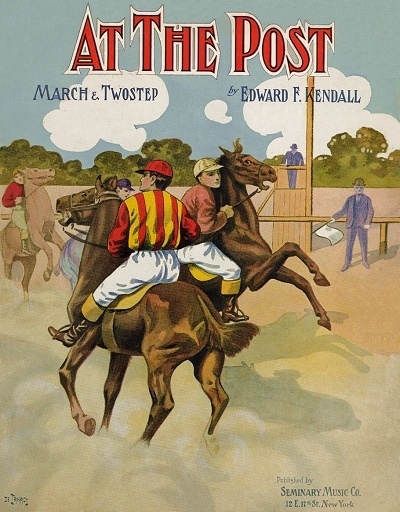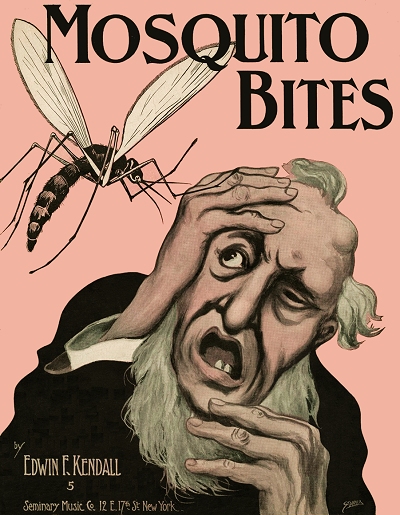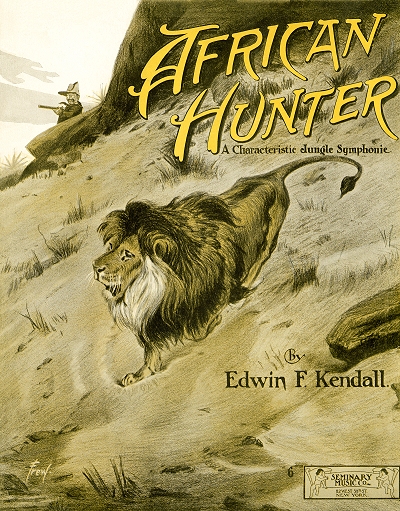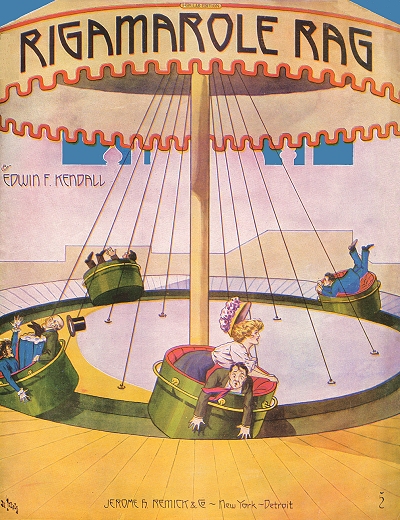 Edwin F. Kendall (March 5, 1870 to May 25, 1920) | |
 Compositions Compositions | |
|
1895
I Have No Sweetheart But You [1]1896
You'll Be My Sweetheart Always [1]The Story of the Roses: Waltz c.1896-1898
Daddy Knickerbocker: MarchNight in Gay New York: March The Sporting Duchess: March 1898
My Heart, Kathleen, Is Still Your Own [2]The Man From Mexico: Valse Espagnole 1899
Shuffling Pete1900
Boots and Saddles: March1901
The Gilded DomeParade of the Cavalry 1902
The Guest of Honor1904
It Was Summer Time in Dixieland [3]1905
A Gay GossoonA Georgia Symphony Come Under the Palm Leaves With Me (An Oriental Love Song) [3,4] 1906
At the Post: MarchNational Patrol: March The Manhattan Rag 1907
Mosquito Bites: RagThe Heroes of the U.S.A. [4] The Cricket and the Moon [5] Katie Darling I Am Waiting [6] Since Little Lena Went to See Salome [7] Mary's Pa [7] My Arizona Girl [8] 1908
Leap Frog: Rag-Time IntermezzoVillage Belles: Barn Dance |
1908 (Cont)
Devil MarchThe Arab's Dream: Intermezzo The Arab's Dream: Song [9] 1909
Drake's Cake WalkThe African Hunter (2 Versions) Charme D'Amour (Love's Spell) Waltz Charme D'Amour (Love's Spell) Song [10] My Peach Basket Girl [10] 1910
Rig-A-Ma-Role Rag1911
Vision of Spain: Waltzes1912
That Scandalous RagMona Darling [4] 1913
Ma Cherie (My Dear)The Isle o' Dreams: Play with Music Incidental Music 1914
Ma Cherie (My Dear) Song [11]c.1915
Bedouin (Film Music)1919
Thoughts at Twilight: Reverie1929
Check and Double Check: Musical [12]
1. w/Malcolm Douglas
2. w/Charles Graham 3. w/Harry S. Marion 4. w/Frank H. Bernard 5. w/Edward M. Wickes 6. w/Margaret E. McCormick 7. w/Addison Burkhardt 8. w/Charles Noel Douglas 9. w/Joseph Snyder 10. w/Louis Weslyn 11. w/Arthur Denvir 12. w/Robert Hood Bowers |
 Selected Rollography Selected Rollography | |
|
1913
That Scandalous RagThat Scandalous Rag Charm d'Amour (Love's Spell) Hungarian Rag Dream Kisses c.1915
Charm d'AmourOh Dry Those Tears Lei Poni Moi (Wreath of Carnations) Akahi Hoi (I Love But Thee) Blue Danube Waltz 1920
Charm d'Amour |
Label
[United States Music 65794][Rythmodik A-5892] [Rythmodik J-6403] [Rythmodik B-6842] [Rythmodik A-6853] [Connorized 10211] [Connorized 10214] [Connorized 10215] [Connorized 10224] |
Edwin F. Kendall represents another case of a working musician/composer who had some moderate success, yet very little is known about him. There are still questions on his history and perhaps some more information to be discovered. This is what the author has uncovered as of 2015. Kendall was born in or near New York City to Martin and Rose Kendall, both immigrants from England. For the 1880 Federal census Edwin was shown as attending school, but also working in some capacity, although the occupation written down is difficult to discern. However, by the next year, his future profession seemed to be in the works, as indicated by an announcement in the Music Trade Review of November 5th, 1881:
A Phenomenon. Master Edwin Kendall, a youth of about eleven years of age, residing in this city [New York], is a young pianist of extraordinary talent. He should receive a thorough and complete musical education. His present teacher is Prof. Bergé.
From that notice it is clear that Edwin received a vigorous musical education, most likely focused piano performance, but with the usual complement of harmony, theory, and even composition. By 1890 Kendall was a teacher, most likely of music, listed in the New York City directory at 255 W. 24th Street. It appears that he also had attended Princeton University in New Jersey around this time period, which may be where he received at least some of his advanced musical training. Edwin next traveled with performer Marshall P. Wilder, "the paradox of humorists," from 1892 through 1894. He was heard with Wilder in an appearance in San Francisco in May 1892. Several notices of performances of Wilder's troupe featuring Kendall on the piano were noted in the St. Paul [Minnesota] Daily Globe in late March of that year, with glowing reports about his playing. The 1894 New York City directory had him listed as an organist. After a couple of seasons with Wilder, Kendall moved north, and was found from at least late 1894 to the late 1890s in Springfield, Massachusetts, listed as a piano teacher living at 76 Main Street.
Kendall's first publication, a sentimental ballad typical of the day, was published in 1895 while he was living in Springfield. A few more were to follow, largely published by The Gagel Brothers in New York City. One was The Story of the Roses, likely to capitalize on a popular book that came out around that time, We Ten (Or, The Story of The Roses). Then there was a Spanish Waltz titled The Man from Mexico, potentially written as an intended theme or incidental music to an H.A. DuCouceht adaption of a French play of the same name. A similar work is The Sporting Duchess, also the name of a play from the same period. Neither of the plays or Kendall's music did particularly well, and it is hard to determine if he was commissioned to compose the works or simply volunteered on speculation. It was while he was still in Springfield that Edwin met, and then married recently divorced Massachusetts native Nellie L. Flynn Moriarty on October 25, 1897.
It was while he was still in Springfield that Edwin met, and then married recently divorced Massachusetts native Nellie L. Flynn Moriarty on October 25, 1897.
 It was while he was still in Springfield that Edwin met, and then married recently divorced Massachusetts native Nellie L. Flynn Moriarty on October 25, 1897.
It was while he was still in Springfield that Edwin met, and then married recently divorced Massachusetts native Nellie L. Flynn Moriarty on October 25, 1897.The Kendalls went back south to New York City for the next two or more years In 1899 Edwin's first cakewalk, Shuffling Pete, was published, and their first daughter, Helen, was born in New York on June 24, 1899. But by June of 1900 Edwin and the family were living in Dracut near Boston where he was working as a piano salesman and later as an accompanist for the Keith theater chain there, the former occupation being the one he listed in the 1900 census. Kendall is shown in programs from September of 1901 through late in 1902. As very few publications are found during this era he must have been constantly working, and one listing indicates he may have also been teaching piano while he was in Boston. Their daughter Virginia C. was born there in 1901. He managed to dash off one a couple of pieces for publisher E.D. Palmer during that period. The Gilded Dome refers to a Boston Landmark, the gold leaf roof of the Bullfinch Front. Whether this was also a commissioned work or simply volunteered is unclear. Parade of the Cavalry was an easy march that got some notice in the trade papers and was heavily advertised by Palmer. By mid-1903 the family was back down in the New York City area, living for several years in Richmond borough near the south terminus of the Staten Island Ferry. He commuted from there to either the publisher's offices in Manhattan or the one of the B.F. Keith theaters where he played. Edwin F. Kendall, Jr., was born there in 1903, followed by Albert F. Kendall in 1904. By the end of that same year he became the manager of the professional department of short-lived publisher Lexington Music Company.
The next several years were the most productive for Kendall, who wrote in a variety of genres, including songs, intermezzos, waltzes and rags. It Was Summer Time in Dixie Land was a brisk seller in the South in 1904. In 1905 his Georgia Symphony was a step towards piano ragtime, composed as a syncopated intermezzo. Another piece that was almost a rag, The Gay Gossoon came out that same year. A recording of his piece was made with Kendall accompanying famed banjo player Vess Ossman in 1906 on an Edison cylinder, the only known audio recording of the composer at the piano. That same year Edwin came out with a couple of marches, followed by his first real rag, Manhattan Rag. This piece was "Respectfully inscribed to Miss Bessie Hammon," but the connection between the composer and Ms. Hammond is difficult to ascertain. In 1907 Kendall was engaged by various lyricists for a few songs, but no big sellers. His Mosquito Bites [Rag] was published by Ted Snyder's new company, Seminary Music. It demonstrated the attitude of many serious composers of piano ragtime concerning performance, particularly in the tempo suggestion, "Quite Slow." He was also the director of St. Brigid's Minstrels that year, which had occasional public performances. In 1908 Edwin's Leap Frog [Rag] sold fairly well for an instrumental, as did The Arab's Dream in both intermezzo and song formats.
A recording of his piece was made with Kendall accompanying famed banjo player Vess Ossman in 1906 on an Edison cylinder, the only known audio recording of the composer at the piano. That same year Edwin came out with a couple of marches, followed by his first real rag, Manhattan Rag. This piece was "Respectfully inscribed to Miss Bessie Hammon," but the connection between the composer and Ms. Hammond is difficult to ascertain. In 1907 Kendall was engaged by various lyricists for a few songs, but no big sellers. His Mosquito Bites [Rag] was published by Ted Snyder's new company, Seminary Music. It demonstrated the attitude of many serious composers of piano ragtime concerning performance, particularly in the tempo suggestion, "Quite Slow." He was also the director of St. Brigid's Minstrels that year, which had occasional public performances. In 1908 Edwin's Leap Frog [Rag] sold fairly well for an instrumental, as did The Arab's Dream in both intermezzo and song formats.
 A recording of his piece was made with Kendall accompanying famed banjo player Vess Ossman in 1906 on an Edison cylinder, the only known audio recording of the composer at the piano. That same year Edwin came out with a couple of marches, followed by his first real rag, Manhattan Rag. This piece was "Respectfully inscribed to Miss Bessie Hammon," but the connection between the composer and Ms. Hammond is difficult to ascertain. In 1907 Kendall was engaged by various lyricists for a few songs, but no big sellers. His Mosquito Bites [Rag] was published by Ted Snyder's new company, Seminary Music. It demonstrated the attitude of many serious composers of piano ragtime concerning performance, particularly in the tempo suggestion, "Quite Slow." He was also the director of St. Brigid's Minstrels that year, which had occasional public performances. In 1908 Edwin's Leap Frog [Rag] sold fairly well for an instrumental, as did The Arab's Dream in both intermezzo and song formats.
A recording of his piece was made with Kendall accompanying famed banjo player Vess Ossman in 1906 on an Edison cylinder, the only known audio recording of the composer at the piano. That same year Edwin came out with a couple of marches, followed by his first real rag, Manhattan Rag. This piece was "Respectfully inscribed to Miss Bessie Hammon," but the connection between the composer and Ms. Hammond is difficult to ascertain. In 1907 Kendall was engaged by various lyricists for a few songs, but no big sellers. His Mosquito Bites [Rag] was published by Ted Snyder's new company, Seminary Music. It demonstrated the attitude of many serious composers of piano ragtime concerning performance, particularly in the tempo suggestion, "Quite Slow." He was also the director of St. Brigid's Minstrels that year, which had occasional public performances. In 1908 Edwin's Leap Frog [Rag] sold fairly well for an instrumental, as did The Arab's Dream in both intermezzo and song formats.Kendall's best known rag came out in 1909, also published by Seminary. The African Hunter was most likely a tribute to by then former President Theodore Roosevelt, clearly pictured on the beautiful John Frew cover. Roosevelt had recently returned from Africa on a well-documented safari to the "dark continent." An unusual aspect of this piece is that it was released in two alternate versions with different key signatures for some of the sections. The more common version may have replaced the rarer one as it follows a more logical key change progression and has a couple of extra transitions, ultimately making it easier to perform. The rag remained a good seller for some time. Also that year he composed Drake's Cakewalk for the Drake Brothers of Brooklyn, the producers of a popular pound cake known as Drake's Cakes. It was followed by a charming waltz, Charme D'Amour (Love's Spell), in both instrumental and song formats. The waltz in particular gained a lot of positive notice for Kendall for its high quality in a time when syncopation was constantly the flavor of the month.
The rag remained a good seller for some time. Also that year he composed Drake's Cakewalk for the Drake Brothers of Brooklyn, the producers of a popular pound cake known as Drake's Cakes. It was followed by a charming waltz, Charme D'Amour (Love's Spell), in both instrumental and song formats. The waltz in particular gained a lot of positive notice for Kendall for its high quality in a time when syncopation was constantly the flavor of the month.
 The rag remained a good seller for some time. Also that year he composed Drake's Cakewalk for the Drake Brothers of Brooklyn, the producers of a popular pound cake known as Drake's Cakes. It was followed by a charming waltz, Charme D'Amour (Love's Spell), in both instrumental and song formats. The waltz in particular gained a lot of positive notice for Kendall for its high quality in a time when syncopation was constantly the flavor of the month.
The rag remained a good seller for some time. Also that year he composed Drake's Cakewalk for the Drake Brothers of Brooklyn, the producers of a popular pound cake known as Drake's Cakes. It was followed by a charming waltz, Charme D'Amour (Love's Spell), in both instrumental and song formats. The waltz in particular gained a lot of positive notice for Kendall for its high quality in a time when syncopation was constantly the flavor of the month.For the 1910 census, the Kendall family was still living in Richmond, New York, with Edwin listed as a musician with a publishing company, which at that time for him was M. Witmark and Sons. Given the known duties of most musicians that worked in that capacity with Witmark and others, he was potentially a song or rag plugger, and perhaps did some arranging as well, although there are no known credits confirming the latter possibility. Such extra duties may in part explain why his only known 1910 piece was the very fine Rig-a-ma-role Rag, published by Witmark's largest rival Jerome H. Remick. Kendall was also the accompanist for the Morealli Quartet performing at Manhattan Beach for the summer season.
In 1911 the only Kendall publication was his Vision of Spain: Waltzes. His last known rag, That Scandalous Rag, appeared in 1912, and his performance of appeared in at least two different roll catalogs. The following year he composed a minor hit, Ma Cherie, which would be brought out as a song in 1914. During this period Kendall was engaged as a pianist in a sometimes traveling troupe headed by singer/composer Chauncey Olcott, particularly in the musical Machushla in 1912 for which he is mentioned in articles of that year.
According to at least two catalogs, Kendall recorded a few piano rolls for the Rythmodik label around 1913, including Hungarian Rag by Julius Lenzberg, and his own Charme D'Amour (Love's Spell) and That Scandalous Rag. Kendall's only known direct contact with Broadway also came in 1913 when he was engaged by prolific producer Henry Miller as a musical director and accompanist for the Irish-themed play The Isle o' Dreams, for which he also composed some incidental music for scene transitions and backgrounds.
Kendall's only known direct contact with Broadway also came in 1913 when he was engaged by prolific producer Henry Miller as a musical director and accompanist for the Irish-themed play The Isle o' Dreams, for which he also composed some incidental music for scene transitions and backgrounds.
 Kendall's only known direct contact with Broadway also came in 1913 when he was engaged by prolific producer Henry Miller as a musical director and accompanist for the Irish-themed play The Isle o' Dreams, for which he also composed some incidental music for scene transitions and backgrounds.
Kendall's only known direct contact with Broadway also came in 1913 when he was engaged by prolific producer Henry Miller as a musical director and accompanist for the Irish-themed play The Isle o' Dreams, for which he also composed some incidental music for scene transitions and backgrounds.Around 1915 Kendall played another handful of rolls, this time for the Connorized label. This was within a few weeks of the period in which Scott Joplin also recorded some rolls for Connorized. There has been speculation, since they also both published with Seminary when Kendall may have worked there, that the composers knew each other, and even that Kendall may have had something to do with setting up the Joplin piano roll sessions. However, this is only speculation and remains, to date, very difficult to validate.
A couple of Kendall's works show up in a Walter Jacobs catalog of around 1915, for which the descriptions indicate that Kendall may have composed some pieces intended for film accompaniment, and hinting that there may have been more such pieces at some point. This would further suggest that Edwin worked as a movie theater pianist for some time, somewhat common for ragtime pianists in the mid-1910s through the 1920s. One final piece, Thoughts at Twilight, appeared in 1919 in an orchestrated version, further suggesting the film accompaniment possibility. A 1920 ad for Rythmodik Rolls shows his name under the heading of "classic and light classic selections," but this was likely for rolls he had done earlier.
The family had moved to Manhattan in the mid-1910s, and they were shown as still living there for the 1920 enumeration with Edwin listed as a musician, but with no publishing association or steady employer. Both Helen and Virginia were working as stenographers, and the family had two boarders living with them as well. He died just four months later in Manhattan at age 50. Ads from 1921 to 1928 for Ampico reproducing rolls indicated Kendall as an artist for that label, but only one performance of his, Charm d'Amour recorded in 1920 just prior to his untimely death, is known of for that company. The family was still living in Manhattan for the 1925 New York State census, and Nellie was shown as widowed, living with all four of her children in Yonkers, as of the 1930 Federal census.
Thanks go to roll collector and historian Robert Perry for information on Kendall's Connorized rolls.